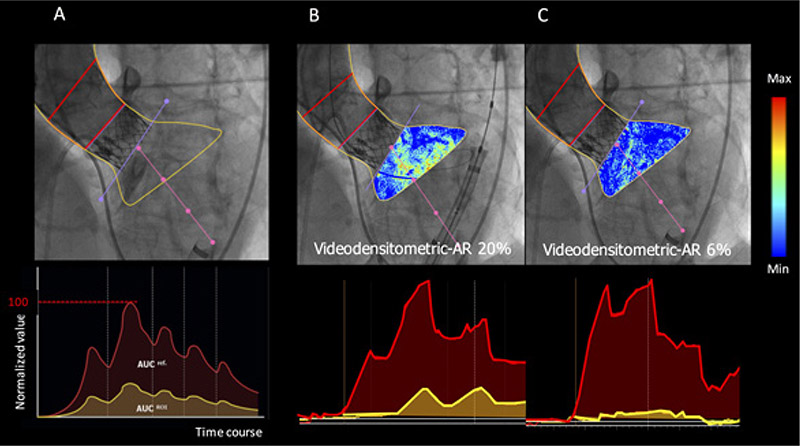Volume 111, Nº 2, August 2018
DOI: http://www.dx.doi.org/10.5935/abc.20180139
ORIGINAL ARTICLE
The Role of Quantitative Aortographic Assessment of Aortic Regurgitation by Videodensitometry in the Guidance of Transcatheter Aortic Valve Implantation
Yosuke Miyazaki
Rodrigo Modolo
Mohammad Abdelghani
Hiroki Tateishi
Rafael Cavalcante
Carlos Collet
Taku Asano
Yuki Katagiri
Erhan Tenekecioglu
Rogério Sarmento-Leite
José A. Mangione
Alexandre Abizaid
Osama I.I. Soliman
Yoshinobu Onuma
Patrick W. Serruys
Pedro A. Lemos
Fabio S. de Brito Jr.
Video 1 – Videodensitometric assessment of aortic regurgitation before and after balloon post-dilatation. Left panel shows VD-AR assessment before BPD (VD-AR = 20%). Right panel shows VD-AR assessment after BPD (VD-AR = 6%).

Figure 2 – Videodensitometric assessment of aortic regurgitation. A) Delineation of the aortic root (reference region: red area in the aortography) and the subaortic one third of LV (ROI: yellow area in the aortography) are shown by the analyser. The time-density curves are provided for both ROI (yellow) and reference (red) regions, and the AUC is automatically computed by the software time-density integrals. VD-AR corresponds to the relative AUC, which is automatically calculated as the ratio of the relative AUC in the ROI (yellow) to that in the reference area (red). Theoretically, the value of VD-AR ranges from 0 to 1. B) An example of VD-AR measurement before BPD. C) An example of VD-AR measurement after BPD. Reproduce and adopted from Tateishi et al. EuroIntervention 201614.
Abstract
Background: Balloon post-dilatation (BPD) is often needed for optimizing transcatheter heart valve (THV) implantation, since paravalvular leak (PVL) after transcatheter aortic valve implantation is associated with poor outcome and mortality. Quantitative assessment of PVL severity before and after BPD is mandatory to properly assess PVL, thus improving implantation results and outcomes.
Objective: To investigate a quantitative angiographic assessment of aortic regurgitation (AR) by videodensitometry before and after BPD.
Methods: Videodensitometric-AR assessments (VD-AR) before and after BPD were analysed in 61 cases.
Results: VD-AR decreased significantly from 24.0[18.0-30.5]% to 12.0[5.5-19.0]% (p < 0.001, a two-tailed p < 0.05 defined the statistical significance). The relative delta of VD-AR after BPD ranged from -100% (improvement) to +40% (deterioration) and its median value was -46.2%. The frequency of improvement, no change, and deterioration were 70% (n = 43), 25% (n = 15) and 5% (n = 3), respectively. Significant AR (VD-AR > 17%) was observed in 47 patients (77%) before and in 19 patients (31%) after BPD.
Conclusions: VD-AR after THV implantation provides a quantitative assessment of post-TAVI regurgitation and can help in the decision-making process on performing BPD and in determining its efficacy. (Arq Bras Cardiol. 2018; 111(2):193-202)
Keywords: Aortic Valve Insufficiency/diagnostic imaging; Angiography/evaluation; Heart Valve Prosthesis Implantation; Transcatheter Aortic Valve Replacement.















